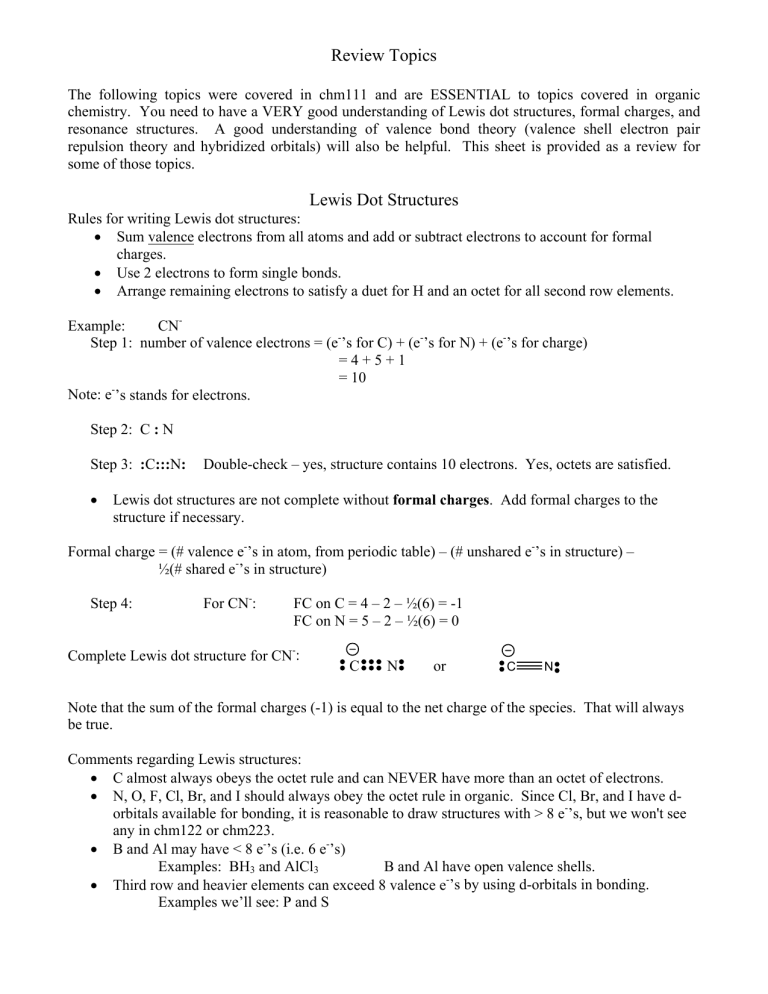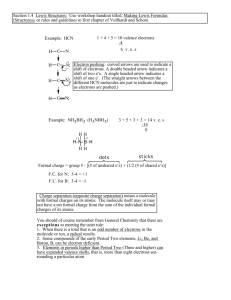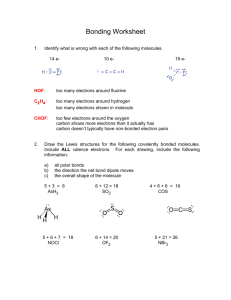CHM122 Review of Intochem

Review Topics
The following topics were covered in chm111 and are ESSENTIAL to topics covered in organic chemistry. You need to have a VERY good understanding of Lewis dot structures, formal charges, and resonance structures. A good understanding of valence bond theory (valence shell electron pair repulsion theory and hybridized orbitals) will also be helpful. This sheet is provided as a review for some of those topics.
Lewis Dot Structures
Rules for writing Lewis dot structures:
•
Sum valence electrons from all atoms and add or subtract electrons to account for formal charges.
•
Use 2 electrons to form single bonds.
•
Arrange remaining electrons to satisfy a duet for H and an octet for all second row elements.
Example: CN
-
Step 1: number of valence electrons = (e
-
’s for C) + (e
-
’s for N) + (e
-
’s for charge)
Note: e
-
’s stands for electrons.
Step 2: C : N
= 10
Step 3: : C ::: N : Double-check – yes, structure contains 10 electrons. Yes, octets are satisfied.
•
Lewis dot structures are not complete without formal charges . Add formal charges to the structure if necessary.
Formal charge = (# valence e
-
’s in atom, from periodic table) – (# unshared e
-
’s in structure) –
½(# shared e
-
’s in structure)
Step 4: For CN
-
: FC on C = 4 – 2 – ½(6) = -1
FC on N = 5 – 2 – ½(6) = 0
Complete Lewis dot structure for CN
-
:
C N or C N
Note that the sum of the formal charges (-1) is equal to the net charge of the species. That will always be true.
Comments regarding Lewis structures:
•
C almost always obeys the octet rule and can NEVER have more than an octet of electrons.
•
N, O, F, Cl, Br, and I should always obey the octet rule in organic. Since Cl, Br, and I have dorbitals available for bonding, it is reasonable to draw structures with > 8 e
-
’s, but we won't see any in chm122 or chm223.
•
B and Al may have < 8 e
-
’s (i.e. 6 e
-
’s)
Examples: BH
3
and AlCl
3
B and Al have open valence shells.
•
Third row and heavier elements can exceed 8 valence e
-
’s by using d-orbitals in bonding.
Examples we’ll see: P and S
Resonance Structures
Rules for writing resonance contributors:
•
Start with a correct Lewis dot structure that includes the appropriate number of electrons!
•
Only nonbonding electrons and electrons in multiple bonds change locations in different resonance contributors. Electrons in single bonds are NOT involved.
•
Nuclei don’t move.
•
Resonance structures that have filled octets for 2 nd
row elements are more important than those with < 8 electrons around 2 nd
row elements.
(FYI, P and S often have > 8 electrons.)
•
Structures with the greatest number of covalent bonds are favored.
•
Resonance structures with little or no charge separation are more important than those with large charge separation.
•
Like charges on neighboring atoms is unfavorable.
•
If a separation of charge is written, the more important contributor is the resonance structure with the negative charge on the more electronegative atom.
1. Complete the Lewis dot structures of the nitrate ion (NO
3
-
) by adding any necessary formal charges.
Notice that resonance arrows are used between resonance structures and electron-pushing arrows
(probably a new concept for you) are used to show electron movement. More information about electron-pushing arrows and how to draw them can be found on the next page of this review guide.
More information is also available on my web page. Look for the handouts entitled “Electron Pushing” by Rosenfeld and “Resonance Structures” by Weeks. Read and complete these worksheets!
O
O
O
N
N
N
O O
O O
O O
2. Complete the Lewis dot structure of ozone (O
3
) by first determining how many valence electrons should be in the structure, then satisfying octets, and finally determining any formal charges. Draw the major resonance contributor. Can you draw the appropriate electron-pushing arrows?
O O O
3. Provide formal charges, if necessary, for the formate ion (HCO
2
-
). Draw 2 resonance contributors and indicate which structures are major and minor. Use electron-pushing arrows to show how electrons move from one structure to the next.
O
C
H O
Electron-Pushing Arrows
Electron pushing arrows ALWAYS start at the electrons.
Example: electrons move toward a positive formal charge.
H
H
C
C C H
H H
Example: electrons move away from a negative formal charge.
H
H
H
C
H H
C
C C H C
H H H
4. Supply electron-pushing arrows for the following resonance contributors.
C
C
H
H
H
C
H
C
H C C N H C C N
H
H
H H
5. Supply formal charges, electron-pushing arrows, and the major resonance contributors for the carbonate ion.
O
C
O O
6. Provide the 3 most important resonance contributors for acetate (CH
3
CO
2
-
). Rank the 3 structures in order of importance and provide electron-pushing arrows that clearly show how electrons move in your first structure to get your second structure and how they move in your second structure to get to your third.



